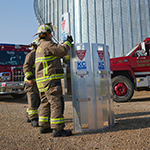Bad grain impacts to harvest and storage
Poor-quality grain can affect your bottom line more than you think.
You may not know it, but handling poor quality grain may have much more of a financial impact on your bottom line than you think.
Definite expenses associated with poor quality grain
The additional expense of locating and blending poor quality grain can have a serious impact on your bottom line. The best answer is to do everything possible to reduce the amount of poor quality grain in the system. Keep in mind that:
- Excessive handling of grain, especially poor quality grain, causes additional damage to grain and increased discounts for damage at the time of sale. Damaged grain can create loss of storage income, loss of grain handling, decreased cash flow (grain merchandising) and a lack of borrowing power because it can plug up your system for long periods of time while it is being blended and sold.
- When grain will not flow through the system properly, or it is so hot that it is not possible to convey it safely, there is difficulty and extra expense of manually unloading damaged grain from grain storage structures.
- Shipping damaged or poor quality grain increases the potential for grain rejection at the delivery point and creates another unexpected expense associated with poor quality grain storage and handling.
- The cost of additional transportation, the extra expense of unplanned transportation costs and the missed transportation opportunities will also impact profitability.
- Other affects of handling poor quality grain can be increased facility and equipment damage, excessive wear and tear, more down time and the inability to make future capital improvements because of lack of funds.
Explosions and fires
Handling and storing poor quality grain increases the potential for damage to facilities. Consider:
- Extra grain handling creates additional amounts of grain dust being generated through the entire operational process leading to an increased potential for dust accumulation and a substantial increase in the possibility and magnitude of a dust explosion.
- Poor quality grain is generally lighter test weight and more susceptible to insect damage; the more it is handled, the more likely it is that the grain will have kernel breakage and damage. Breakage and damage of kernels also increases the amount of dust being suspended, as well as the risk for a dust explosion. Hot grain dramatically increases the potential for grain fires during extended storage periods.
- An increased amount of grain and poor quality grain being conveyed increases the potential for a dust explosion.
- Increased drying times and the need to dry multiple times creates an additional drying expense, and the poor quality of the grain being dried increases the likelihood for dryer fires or explosions. (Yes, dryers have blown up due to excessive dust from poor quality grain.)
- Grain fires due to "out of condition" grain can cause extreme loss of market value, increased property damage, increased potential for employee injury and additional scrutiny or fines from OSHA.
Workplace health and safety hazards
The potential employee health and safety hazards created when dealing with poor quality grain can be serious. Consider the following:
- The additional storage and handling of poor quality grain can put employees at risk for injury due to the need to perform hazardous tasks like bin entry, additional or emergency repairs to equipment and the need to work longer-than-normal hours.
- Poor quality grain increases the potential for injury due to exposure to smoke, heat or fire, as well as the possibility of sickness and disease due to contact and inhalation of molds and Mycotoxins formed during the grain decomposition process that are released into the atmosphere when the grain is handled again and again.
- In addition to injury and sickness that could occur, there is always the possibility that employee retention will be affected. After all, no one really likes to work in a hot, dirty and dusty environment.
The total financial effect of trying to manage poor quality grain may never be known, but everybody should be aware of all the potential costs associated with failing to properly manage grain condition and the extent of the affect handling poor quality grain has on the overall business operation.
Do everything you can to prevent stored grain from being affected by loss of quality, spoilage or heating during storage. Get your plan together, review it with employees and make the effort now to prepare for managing poor grain quality effectively. Otherwise, your business could suffer the financial consequences of handling and storing poor quality grain.

 >
>

 >
>
 >
>